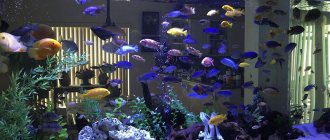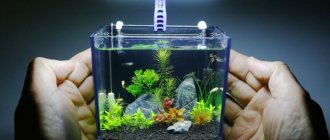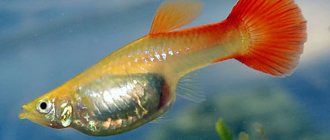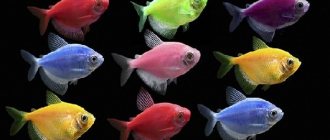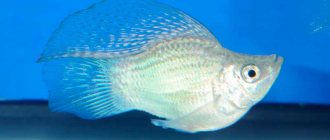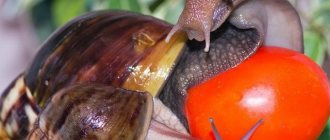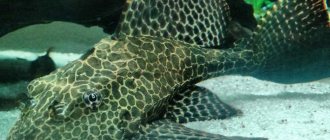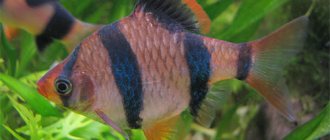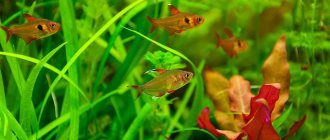Recently, small aquariums have become increasingly popular. And here everything is clear, because not every person has a large apartment in which there is room for a large aquarium. And the aquarium itself and the equipment for it will cost a lot of money. In this regard, with a small container it is much easier, because it can be placed on a desk or on a chest of drawers, and the equipment for it is several times cheaper.
But a 30-liter aquarium also has its drawbacks: the choice of fish for it is smaller than for a large one, and it is difficult to maintain balance in it. Overfeeding or death of a pet can lead to a bacterial outbreak and an increase in nitrate concentrations, which will have a detrimental effect on the fish. Therefore, it is very important not to overfeed hydrobionts and not to overpopulate the aquarium.
Choose a rectangular or square container. Install a small filter and thermostat into it. To make your pets comfortable, plant small plants: sagittaria, cryptocarina Wendt or pontederifolia, marsilia, white-headed stinkhorn, tie moss or anubias to a small branched snag or lava. Let a sprig of hornwort, duckweed or limnobium float on the surface.
What kind of fish should I put in a 10 liter aquarium?
A small aquarium is a tank with parameters of 20x40 cm or less (nano aquarium), in which you can place small ornamental fish. The volume of such containers can be from 10 to 20 cubic liters, so they are suitable for installing decorations and equipment. In a small aquarium you need to install lighting, plant plants, decor, and don’t forget about the filter and compressor. That is, a small aquarium should not differ in functionality from a spacious one.
How to set balance in a mini tank?
Caring for a small aquarium, on the one hand, is easy, but on the other, it will cause trouble. Choose a rectangular mini tank with straight and smooth walls. They are convenient to clean with a scraper and maintain. If the container is round, then getting to its corners will be inconvenient and difficult to clean. A 10-liter aquarium gets dirty faster than a 50-100-liter one. Water changes will have to be done more often, as well as comprehensive cleaning, which is not beneficial for the biobalance of the aquatic environment and the health of the fish.
The main disadvantage of mini tanks is the small amount of water. It won't hold a lot of fish. You can put 1-2 fish there, and no more. In a large aquarium, water changes are not very noticeable, but in a small aquarium it is a lot of stress. Any changes in the biological balance: death of fish, overfeeding, pollution immediately affect the aquatic environment. The only thing that can be done is to adjust the water parameters in time, carefully feed the fish, and clean the bottom.
See how soil siphoning occurs in a nano aquarium.
You need to care for a small aquarium in the same way as a large one. Once a week you need to change 10-15% of the water, if necessary. To avoid stress for the fish, do not completely replace the water, try to add it in small portions. The ideal aquarium filter for such a tank is a pump with an internal sponge. The sponge should not be washed under running water, otherwise all the beneficial bacteria involved in the nitrogen cycle will die.
If you choose the smallest tank, it will be almost impossible to install plants and decorations in it. Some skillfully plant dwarf plants even in 3-liter jars, but they are inconvenient to care for. In a 10-liter tank it is possible to keep dwarf Anubias, dwarf arrowhead, Echinodorus “dwarf Amazon”, and dwarf Cryptocoryne. Plants for a small aquarium are able to control the level of nitrites, nitrates and ammonia, and create hiding places for fish. Make sure there is soil in the aquarium. Choose a substrate that is processed, clean, and without paint. Remember that it is very difficult to clean out a layer of plaque from aquariums of minimal size with a regular scraper.
Now about feeding. As you know, overfeeding not only harms the health of the fish, but also negatively affects the quality of water. Everything uneaten decomposes, turning into harmful impurities and bacteria. Decay products settle on the bottom and frames of the tank, disrupting the stability of the biological environment. The fish must be well-fed; hunger is also not an option. Once a week, arrange fasting days for the fish. Add food in 4-6 grains, as large as your pet can swallow. What is not eaten must be removed with a gauze net.
Give fish that live in a small 10-20 liter nursery as much food as they can eat in 2-6 minutes. Flakes, live food, and sinking pellets are fine. They sink slowly and do not pollute the environment. If you have bottom-dwelling catfish, they will eat everything on their own. The fish can be fed with their usual nutritious food without disturbing their diet. It is important to clean everything on time.
See how to decorate a small aquarium.
What kind of fish is suitable for a mini aquarium?
What fish can be kept in mini aquariums? Pets with miniature body sizes should be placed in a small 10-20 liter tank. Fish 2-6 centimeters in length will tolerate this volume of water. But remember that even small fish want to swim in a spacious environment. They should not be kept in containers that will restrict movement. Territorial and aggressive fish should not be placed in mini aquariums. Which ones should not be placed in 10-liter aquariums? These are swordtails, medium-sized barbs, cichlids, gourami, and zebrafish. They have an active and energetic disposition and require more hiding space.
In an aquarium of 10-20 liters you can put small barbs, Gertrude pseudomugil, rice fish, cherry barbs, rasbor, erythrozonus, neons, Amanda tetra. You can also keep the following fish and shrimp there: otocinclus catfish, corydoras, amano shrimp, cherry shrimp, copper tetra. Representatives of the genus Poeciliaceae, viviparous fish, get along well in mini tanks.
You need to buy fish breeds with strong immunity, that is, not purebred fish, but hybrids. If you do not have the opportunity to buy a spacious “house” for your small pet, you need to buy a small aquarium with a capacity of 10 liters. The well-known Siamese cockerels are also often housed there. The cockerel can live alone and does not get along with its relatives; it is a fighting fish, after all.
See also: Small aquarium fish.
AkvariumnyeRybki.ru>
Keeping and caring for goldfish
Rules for settling in an aquarium
- Buy a wide aquarium. Make sure there is enough space in the tank for your pet. Veil-tailed goldfish require approximately a 45-90 liter aquarium. Goldfish grow quite quickly, and if you plan to provide them with proper care, buy a container that will accommodate already mature specimens, which will save you later from replacing the tank with a larger one.
Look at a well-designed goldfish aquarium. - Place a quality filter in the tank. Goldfish are known to be inveterate messy creatures and leave behind a lot of trash. Your filter must thoroughly clean the water, preferably 10 times in 60 minutes. If you have a 20 liter aquarium, then you will need a filter that can pump at least 200 liters. at one o'clock. Another suitable filter is one that pumps more than ten times the volume of water in the tank.
- The nitrogen cycle must be established in the aquarium. You need to buy a water device with an indicator that will clarify the saturation of water for nitrites, nitrates and ammonia. Do not buy test strips, they will not provide an accurate result. Use a special chlorine removal liquid to remove toxic chlorine from the water. Line the bottom of the aquarium with a pea-sized amount of gravel (small so that your pets cannot choke on it). Make sure that the pebbles or gravel do not contain metal fragments, as pebbles with metal have a good chance of harming creatures if toxic elements dissolve in the water.
- Buy a small amount of decorations and decorations. The animals would love it and add some variety to their small home. Do not buy decorations with small holes so that the goldfish cannot settle there. Take into account the size of the mature specimen (sometimes they grow to the thickness of a grapefruit!), and then set up the decorations. You can add seaweed; goldfish like to nibble on living plants, as a rule, these are: anubias, valsa, cryptocoryne and others.
- Buy goldfish that are healthy in appearance. Be careful with an aquarium that contains non-living fish, this may indicate symptoms of a disease or improper care.
- Do not place the purchased fish immediately into a community aquarium. Leave it for a 2-week quarantine in a separately prepared container with infused water. This procedure will prevent fright and diseases that the fish could bring from the previous aquarium.
- Contrary to arguments, it is not recommended to place veil-tailed fish in a round container or nano-aquarium. She will feel uncomfortable there and her vision may deteriorate. Do not place the fish in a tropical aquarium with heat-loving fish. Goldfish is a cold-loving animal that comes from temperate latitudes.
- After quarantine, the goldfish can be released into the aquarium. Do not rush to introduce the fish into an unfamiliar aquatic environment. Upon returning home with a new resident, lower the closed plastic package containing the goldfish into your aquarium for approximately 10 minutes. This will help the fish adjust to the temperature in the tank. After this, add a few drops of water from your aquarium to the package with the fish, and wait another ten minutes. Then use a net to slowly transfer the fish into the aquarium. Pour the bagged water into the sink or drain. This process not only limits stress for the animal, but also prevents contamination of the water in the tank with store water. Then create a schedule for how to care for your pet each day.
Watch a video about keeping a goldfish.
Rules of care and maintenance
AkvariumnyeRybki.ru>
Aquarium fish for a small aquarium
An aquarium whose volume reaches 50 liters is considered small. If you want to avoid common mistakes when selecting fish, use the following tips from experienced specialists.
Tips for selecting fish
When purchasing a fish, ask your sales assistant what size it will reach when it grows up. Sometimes a small fish can turn into a predator over time, and significantly reduce the number of fish in your aquarium.
Maintaining optimal conditions in such an aquarium is quite difficult, so you should not buy too expensive exotic fish; such specimens die first if the ecological balance is disturbed.
Calculate the optimal number of fish in the aquarium, based on the calculation - 3-5 liters of water per fish with an average length of 6 centimeters. Do not overload the aquarium with a large number of fish, they will be uncomfortable.
Try to get fish of the same “temperament”. If some fish are inactive, while others begin to rush around the aquarium, the first ones are unlikely to get food.
Make sure that the vital volume of the aquarium is filled evenly, that is, fish living in the bottom layer of the aquarium should be combined with fish swimming in the middle layer and fish located near the surface
Fish in a small aquarium
The ideal fish for a small aquarium are guppies. It is possible to purchase approximately 15 intricately colored fish, and this will be enough for a 50 liter aquarium.
Small aquariums work well for swordtails of various colors. Red platies, as well as spotted and calico platies, have proven themselves well. Black mollies are more demanding on the composition of the fish's water; they need to add a little salt. All these fish are viviparous, and they require approximately the same conditions of detention. You can also place spawning fish in a small aquarium. Striped Sumatran barbs look very impressive next to the mossy dark green mutant barbs. Small striped zebrafish are very unpretentious; veil-shaped cardinals look very beautiful.
Fans of larger fish should purchase several angelfish or pelvicachromis parrots. Any aquarium will be decorated with red, blue or ordinary neons, but these are quite expensive fish.
It is useful to add ancistrus catfish to the aquarium, which have the ability, with the help of a suction cup mouth, to clean the walls of the aquarium, as well as plants, from green algae fouling.
Fish combinations
8lap.ru>
Required knowledge
A small aquarium is especially popular among beginners. With its help, you can become better acquainted with the process of keeping fish and gain experience for further improvement. More experienced aquarists use such tanks for breeding fish and keeping individual fish.
Aquarium size
To become passionate about this activity for the rest of your life, even the smallest 10-liter aquarium is enough. It will be enough for fish, since some of them can live in smaller volumes.
As a rule, an aquarium with a capacity of less than 50 liters is called small. You can house several small inhabitants or one larger one. With such a tank you can decorate the interior of the room in an original way and add some zest to it.
However, we should not forget that even the smallest aquarium needs thorough cleaning and maintaining the most comfortable conditions for its inhabitants. To do this, you need to use devices that have quite impressive dimensions and will hardly fit in a small tank. It is impossible to exclude them, as the pet will not be able to live without them for even one day.
Experienced aquarists recommend using 30 or 40 liter containers. They have more free space and it is possible to accommodate several small species at once.
Settlement rules and species compatibility
Small fish aquariums are good for their decorative value, but they do not allow them to be populated with many different species, so a novice aquarist has to make a difficult choice in favor of one or another aquatic creature. The best option would be two or three fish for a 10 liter aquarium.
If you ignore the rules of settlement, you can create uncomfortable conditions for your pets, which will lead to health problems or death. In addition to fish, the container must contain small stones, sand and other materials that will create the bottom of an artificial reservoir. It is important to plant several types of aquatic plants in the aquarium. They will help purify water and become a source of food for pets.
When choosing fish, it is important to consider their habitats. Depending on this indicator, aquarium creatures are divided into the following categories:
- benthic (live mainly at the bottom of an artificial reservoir);
- living in the middle strata;
- floating near the surface of the water.
The main criterion when choosing fish is their compatibility with each other.
The ideal option would be to accommodate representatives of each category in the tank. This way they will be evenly distributed throughout the aquarium and will not interfere with each other.
The inhabitants of a small tank should be selected depending on several basic factors. The main one is the compatibility of the species with certain inhabitants. It is at this stage that beginners make most of the mistakes and put completely opposite species in the same body of water. Because of this, the fish harm each other and quickly die.
To avoid this, it is necessary to take into account the advice of experienced aquarists and strictly follow them. Among them the following stand out:
- Some species cannot live alone, so they need to be housed in small flocks of 3-5 individuals.
- All selected fish must live and reproduce under the same temperature conditions and water parameters.
- Any neighborhood is possible only with the introduction of peaceful species of aquarium inhabitants.
- The number of individuals depends on the volume of the tank and the individual characteristics of the species.
- It is important to consider the fact that some peaceful species do not get along well with each other. In this case, you need to refuse to place them in one aquarium and look for more suitable options.
Small aquariums are a high-risk area for their inhabitants. They have very little hiding space, so the life of pets depends entirely on the choice of the owner. For example, if you add a predator to small fish, it will immediately eat them.
Large predators such as cichlids should not be placed with small fish.
Fish for a small aquarium: how to choose
If you need to populate a small aquarium with fish within thirty liters, then you need to know a few rules.
A few important rules
Rule one. A fish for a small aquarium should not be predatory. Often they buy fry without thinking about what size they will reach when they mature. Therefore, you need to ask the seller about the maximum dimensions of an adult.
Rule two. Fish for a small aquarium should not be rare or expensive. In such containers it is difficult to maintain the desired mode consistently. If the ecobalance is disturbed (for example, due to excess feed), they will be the first to die.
Rule three. You don't need to have a lot of fish. One individual 5 cm long requires approximately 4 liters of water. It’s easy to count: unpretentious fish for a small aquarium with a volume of 30 liters in the amount of 7-8 pieces. will feel quite comfortable.
Rule four. There is no need to create individuals that are very different in behavioral factors. For example, some fish are constantly moving, while others are inactive.
Rule five. It is necessary to start fish taking into account the uniform filling of the vital volume. For example, territorial individuals may occupy more space in the container, which will cause great inconvenience to other inhabitants. In addition, the fish need to be combined vertically so that there is no overpopulation of any of the water layers (bottom, middle, upper).
Types of fish for a small aquarium
Viviparous
The most common inexpensive fish for a small aquarium is the guppy. If you wish, you can find beautiful specimens with intricate colors. Swordtails of different colors also feel good in such containers. They are red, black, spotted, green. In addition, swordtails and guppies can coexist well together.
Another fish for a small aquarium is the black molly. It is more demanding on the temperature and mineral composition of water. That's why they add a little salt to it. Red disk platies are especially spectacular. All these fish are similar in terms of keeping, feeding and care.
Fish spawning
fb.ru>
Choosing an aquarium for betta fish
Many cockerels are sold in pet stores, where they are housed in small glass jars. Is it right to keep fish in such conditions? Of course, this is not advisable. Despite the endurance of the fish, aquariums for bettas should be spacious enough for free movement. These fish will show their color as brightly as possible and straighten their fins if they live in a comfortable environment. It is important that your betta fish can easily turn around in the tank without limiting their movements. Moreover, it is impossible to place plants, decorations, or a filter in a cramped container.
Improper housing leads to pet diseases and other negative consequences. Sometimes the jars where the cockerels were kept could contain medications (methylene blue), but there was no heating at all. In general, fish simply will not survive if their space is limited. Where can they be placed?
What aquariums are suitable for milking bettas?
Of course, aquarium fish cannot live in a glass of water or in a 1.5-liter jar. The average size of cockerels is 5-6 cm, so they require a little space, but with room for free movement. If you can’t purchase an aquarium, you can place your pet in a 3-5 liter jar of infused water for a while. Oddly enough, you can place some decorations or plants in it. However, the betta is not a Spartan, so the best conditions for it are special aquariums for bettas. It will be pleasant to watch the fish through the decorative tank, where it can quickly get used to it and even produce offspring.
Look at what aquariums there are for keeping cockerels.
A 20 liter rectangular aquarium may be simple in appearance, but it is better suited for fish than a glass jar. Betta fish can calmly turn around in it and enjoy the scenery; in such a tank it is possible to maintain stable water parameters. It will not overheat too much, maintaining a stable biobalance. In a 20-liter aquarium it is easy to create an aquascape with decorations, plants, driftwood and stones. You can even throw not one, but two fish into it.
10-liter rectangular - if you do not yet have the opportunity to buy a 20-liter aquarium, take a smaller tank. This is the minimum allowable volume for keeping one adult rooster. However, maintaining the balance of the aquatic environment here is much more difficult; it will quickly become polluted and heat up.
Aquarium for bettas is round - there is an opinion that many bettas finished their best years in round containers, but this is not entirely true. Round tanks are a good place to keep your pet in quarantine until she gets used to her new environment. Round containers serve as good carriers for fish; you can install small decorations and even a filter in them. It is more difficult to remove such a structure - a regular scraper will not cope with algae settled on the glass. A brush won't help. It is believed that tanks of this shape have a bad effect on the vision of bettas; they distort its appearance from an optical point of view. Of course, you can choose such an aquarium, but rectangular shapes are much better and more practical. They are easier to maintain.
Look at the original idea of keeping bettas.
Are there special aquariums for bettas?
For a 5-centimeter fish, a well-decorated tank is suitable. You want your fish to have a full life, right? Then take into account the fact that the optimal aquarium for a betta is one made in production. Many companies offer aquariums for betta fish in round, rectangular, even square shapes. They are immediately equipped with a lamp, lamp, decor, and filter. Another thing is that cockerels do not need constant lighting, so the lamp does not need to be kept on all the time. Algae love light, but why do you need the extra hassle of cleaning?
Try buying a simple 20-50 liter rectangular tank with a filter and lamp. You can install decorations, soil, and shelters yourself if you know how to handle them correctly. Before placing the fish, rinse the glass container under running water and treat it with baking soda, rinsing it 4 times. It follows from this that the best house for a betta fish is a classic rectangular one, which has everything to recreate a natural biotope.
AkvariumnyeRybki.ru>
Lighting
There are different versions of lighting in aquariums, and of course. Fish should not be left completely without lighting. Fish need light just like they need oxygen. But a small ten-liter aquarium will heat up too much from the constant presence of a lamp on the inside of the aquarium lid, so in this case only external lighting will work for you - a small pendant lamp with a fluorescent lamp will be quite enough. When wondering whether you need to keep the lights on all the time, you can safely answer yourself “no.” If in nature fish observe the change in time of day, noticing dark and illuminated water, then ornamental fish require light in the same way.
You can equip the aquarium with a lamp with a timer so that the light turns on and off automatically every twelve hours: this will be quite enough for the fish and will not create any problems for the owner of the animal, because you won’t have to worry whether you turned the light on or not for the fish.
Peaceful bright fish for the home aquarium
Schooling fish
Other peaceful species
AkvariumnyeRybki.ru>
Iriatherina werneri
Although the males of these fish of the Melanothenia family may fight with each other, they are actually peaceful fish. They are often victims of other fish that like to pluck their long fins, so it is better to place them with the same peaceful species. When kept in a good and spacious aquarium with a volume of 50-60 liters in a group of at least 6 individuals, they will demonstrate interesting behavior and a good disposition towards similar neighbors.
Look what Iriatherina Werner looks like.
Marbled Carnegiella (Carnegiella strigata)
Marbled Carnegiellas are an excellent choice for a 60-100 liter aquarium. They swim in the top layer of the aquarium. They have a very interesting appearance: their wedge-shaped abdomen and motley color immediately attract the eye. They are calm and shy and may leave other fish alone. Aquarium fish stay in groups; it is recommended to stock a school of at least 6 individuals. The school prefers to swim in the upper layers of water without disturbing the peaceful bottom fish. However, the aquarium must have a lid to prevent the fish from jumping out of it. Sometimes you hear blows on the lid, which means it is frolicking or demanding attention.
Catfish
Twig fish or Farlowella catfish (Farlowella vittata)
The Farlovella catfish is an excellent choice for hobbyists who want to take care of the cleanliness of their home aquarium. These herbivorous catfish will definitely not hunt fry of other fish, or even small fish. They prefer calm, peaceful aquariums, where there is no place for hostility. They do not take food from others, but eat up its remains.
They grow up to 15 cm in size, so they should be placed in spacious aquariums with a volume of at least 120 liters. Sensitive to parameters of the aquatic environment. Twig fish are the best algae eaters. To maintain them, constant feeding with plant food is necessary - zucchini and algae plates, otherwise they will eat aquatic plants. Compatible with peace-loving fish that swim in the upper layers of water.
Otocinclus affinis
Panda catfish (Corydoras Panda)
Panda corydoras are small fish of the armored catfish family. They can live in an aquarium with a volume of 50-100 liters. These are bottom-dwelling fish that prefer rectangular aquariums with a sandy substrate. Like other aquarium catfish, they must live in a group of 5-7 fish to feel safe.
They are friendly, friendly, and sometimes play games and catch up without harming each other. Sometimes exhibit hyperactive behavior. The best neighbors for them are other small fish, and small fish up to 5 cm in size, which do not show an aggressive disposition and swim in the upper and middle layers of water. It is important that the catfish get the food they collect from the bottom.
Viviparous species with a peaceful nature
Guppy
Swordtails
How many fish can you keep in an aquarium?
How not to do it
Factors that determine the number of fish in an aquarium
- Let's start with the physical and chemical parameters of water (acidity, amount of nitrogen compounds, O2 saturation and temperature).
The most important limiting factor is the oxygen content of the water. Plants and technical means (as additional sources of this gas) make it possible to increase the density of fish stocking.
It’s easy to determine its limit: if the fish try to spend most of their time near the surface, frantically swallowing air (with high-quality aeration!), then you have overpopulation.
At the same time, you need to check the temperature of the water, since when it increases, oxygen dissolves less well in water.
- The next factor is the number, size, weight, age, feeding activity and growth rate of the fish.
The larger the individual, the more secretions it produces. They, as well as leftover food, decompose and release toxic ammonia. If there are too many fish, then it simply will not have time to be processed and will poison the aquarium. The acceptable number of fish can be determined by using good tests to conduct a chemical analysis of the water for the content of nitrogen, ammonia, ammonium, nitrites, nitrates and analyzing the results.
- It is important whether there is soil in the aquarium, what quality it is and in what quantity.
- Are there living plants and what type are they?
- Is filtering equipment used and what kind; how often the aquarium is maintained (water is changed, soil is cleaned, etc.).
- How often and in what quantities is food given, what is its quality and chemical composition, what percentage of the fish eat it. There are other, but not so important factors.
Methods for optimally filling an aquarium
In aquarium farming there are several options for determining the optimal filling of a reservoir. The simplest, but also the most controversial is called the “3.5 cm per 5 liters of water” rule, where 3.5 cm is the total length of all fish. There are pitfalls here:
- It is necessary to know in advance the final dimensions of the adult individual.
- It is necessary to take into account the size and shape of the fish. Large, plump inhabitants produce noticeably more waste, which means they need more water than elongated and slender ones.
- You only need to take into account the actual volume of water, minus that occupied by soil, plants and other accessories, and this is minus about 15 percent.
The following method is based on determining the surface area of the water. (To find out, you need to multiply the width and length of the aquarium.) The larger it is, the more intense the oxygen exchange and the greater the number of fish that can be placed in the container. For large fish, the optimal ratio is 3 cm of body per 150 cm² of surface, for elongated fish - 90 cm². The method is especially good for aquariums of complex shape. Although the calculations here are also approximate and you should always leave some margin.
A few more important requirements
- Use the “1 cm per 1 liter” rule only for small, thin, non-aggressive and unpretentious fish.
- The greater the length and height of the fish’s body, the greater the volume of water it needs. For example, a 20 cm discus requires at least 40 liters of water.
- Fat and “slimy” fish need more water. For example, a 25 cm goldfish needs at least 30 liters.
- Small aquariums are only suitable for small fish.
- The more aggressive the fish, the more volume it needs.
- Schooling fish are best kept in large aquariums.
- A densely planted aquarium with good filtration will allow more fish to live.
- Inhabitants should be selected so as to evenly populate all layers. You can find out “who is who” using a simplified scheme: the mouth is turned upward - the top layer, directed along the middle line - the middle layer, looking down - bottom rock.
Specific liters for a specific fish
Some practical authors share their experience and tell us which species, in what quantities and in what aquariums feel great (subject to normal filtration and regular care). Here are some such tips:
- Small fish (up to 4 cm: neon, cardinal, rasbora, guppies) can be kept in aquariums from 10 liters with a stocking density of 1 liter per 1 fish.
- Small ones (up to 6 cm: platie, ternetia, hassemania, rhodostomus, minor, barb, guppies) in 20-liter containers with a stocking density of 1.5 liters per 1 fish.
- Small peaceful ones (up to 10 cm: swordtail, mollies, Congo barbs, cross and black, apistogramma) in aquariums of at least 150 liters. Density 3-10 liters per 1 fish. Moreover, for school animals you need less water, and for solitary fish - from 5 liters per piece.
- Medium peaceful (up to 20 cm: angelfish, golden, gourami, Malabar zebrafish) in an aquarium from 200 liters. It’s hard to name rules; there are many exceptions. It all depends on the fish, its weight, behavior, habits. The larger the volume, the more you can increase the planting density.
- Small cichlids up to 10 cm need 40 liters per pair.
- For Malawian cichlids: an aquarium from 150 liters, with no more than 10 liters per fish. Such overpopulation is even necessary; it reduces their aggression.
- Large fish (up to 30 cm: acara, astronotus, cichlazoma) are placed in pairs in 250 liters or tens in 500 liters.
- Discus fish need an aquarium of at least 200 liters and at least 50 liters per fish.
- It is better to stock very large ones (arowana, snakehead, clary catfish) in aquariums at least 1.5 m in length. For 500 l 1-2 fish.
- Catfish and bots. They are bottom-dwelling and can be ignored in the total number. The larger the aquarium, the larger the breed you can plant. There is one “sucker”, no more than 5 “diggers”.
- Labyrinthine. One cockerel will need 0.5-2 liters. Gourami – 20 liters per couple.
What conclusion can be drawn from all this? And such that you need to listen to the recommendations, but not blindly follow the rules, especially outdated ones. Each aquarium is unique and each requires an individual approach. We hope that our information will help you correctly solve the problem of “how many fish can you keep in an aquarium.”
aquariumguide.ru>
Edges of a round aquarium
Flaws
Equipment
Choosing fish
Even if the filter, compressor and heater are selected perfectly, not all types of fish can be kept in 10, 20 or 30 liters of water. So which fish should not be placed in a flask?
- Large ones. Which require several tens of liters per individual will die immediately in a round aquarium.
- Nervous. Keeping fish that are sensitive to change is impossible in a flask. No matter how luxurious a filter or heater you equip the flask with, it always distorts light and shadow, and this will constantly frighten the fish.
- Packy. Fish that are accustomed to living in schools will wither away. They will suffer from lack of space. And it will not be possible to start a full-fledged flock, which will become additional stress.
Species that are undemanding to temperature are suitable for keeping (however, this does not mean that a heater is not needed): swordtails, guppies, platies, corydoras, macropods, neons. Fish that are not sensitive to the oxygen content in the water, of which there are many, will also get along in the flask: cockerel, small gourami, macropods.
It is important to take into account that the aquarium will allow you to establish normal care for only one or two individuals. Baby guppies and neons should not exceed 10 in number.
By the way, the selection of equipment should be done after you have decided on the type of fish that will live in your planned aqua world.
gold fish
No matter how much you would like to decorate your home with a flask with a golden beauty inside, it is better to abandon the idea.
Firstly, goldfish are classified as large species. A ball aquarium has a small volume: one fish requires at least 20-30 liters, but not 10. If you buy an aquarium of 20 or 30 liters, the goldfish will be uncomfortable, even if you equip the aquarium with a filter. You can opt for smaller varieties of goldfish, such as telescopes.
Once you decide to get a goldfish, you will have to really clean the aquarium often, carefully control the amount of food, and change the water. Is it worth the hassle of keeping one goldfish (which will be uncomfortable anyway)?
Cockerels
Plants
Arrangement and care
NashiRybki.ru>
Which fish are best suited?
In fact, almost all types of fish that have favorable colors create good feng shui, although the temperament and habits of the fish are also important. Therefore, you can choose any fish that you like. However, from the point of view of attracting money, goldfish are preferable according to the teachings of Feng Shui, and here’s why.
The Chinese word "gum yu" has a double meaning: "goldfish" and "gold in abundance." Therefore, goldfish are considered a symbol of wealth and abundance in the science of Feng Shui. By the way, they used to be incredibly expensive, and only very wealthy people could afford them.
To attract money luck, choose bright red, healthy and active individuals. Sick and lethargic fish are not suitable for the role of a money magnet.
